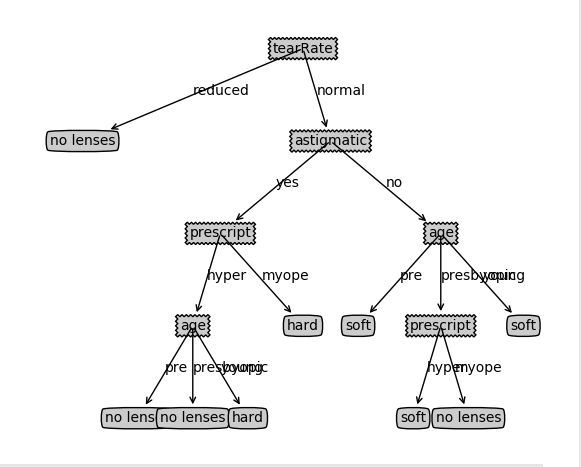构造决策树时需要解决的第一个问题是:当前数据集中哪个特征在划分数据分类时起决定性作用。
划分数据集的原则:将无序的数据变得更加有序
信息增益:在划分数据集前后信息发生的变化
获得信息增益最大的特征就是最好的特征
熵:信息的期望值,表示信息的混乱程序,越混乱熵越大
信息增益可以表示为信息熵的减小

[https://blog.csdn.net/moxigandashu/article/details/71305273?locationNum=9&fps=1]
以下代码均在trees.py文件内。
计算给定数据集的信息熵:
from math import log
import operator
import treePlotter
def calcShannonEnt(dataset):
numEntries=len(dataset)
labelCounts={}
for featVec in dataset:
currentLabel=featVec[-1]
if currentLabel not in labelCounts.keys():
labelCounts[currentLabel]=0
labelCounts[currentLabel]+=1
shannonEnt=0.0
for key in labelCounts: #遍历字典,key是字典的键
prob=float(labelCounts[key])/numEntries
shannonEnt-=prob*log(prob,2)
return shannonEnt
根据给定特征及特征值划分数据集:
def splitDataSet(dataset,index,value): #按照给定特征划分数据集。index,value两个参数用来确定特征及其特征值
retDataset=[]
for featVec in dataset:
if featVec[index]==value:
reducedFeatVec=featVec[:index]
#print(reducedFeatVec)
reducedFeatVec.extend(featVec[index+1:])
#print(reducedFeatVec)
retDataset.append(reducedFeatVec)
#print(retDataset)
return retDataset
def createDataSet():
dataSet=[[1,1,'yes'],[1,1,'yes'],[1,0,'no'],[0,1,'no'],[0,1,'no']]
features=['no surfacing','flippers']
return dataSet,features
选择最好的数据集划分方式,即为确定最恰当的特征:
def chooseBestFeatureToSplit(dataset):
numFeatures=len(dataset[0])-1 #确定特征个数
baseEntropy=calcShannonEnt(dataset)
bestInfoGain=0
bestFeature=-1
for i in range(numFeatures):
featureList=[example[i] for example in dataset] #第i个特征的所有特征值
uniqueVals=set(featureList) #将所有特征值去重,得到标称型数值
newEntropy=0.0
for value in uniqueVals:
subDataset=splitDataSet(dataset,i,value)
prob=len(subDataset)/float(len(dataset)) #第i个特征值为value的记录个数与数据集总数的比值代表第i个特征值为value的概率
newEntropy+=prob*calcShannonEnt(subDataset)
infoGain=baseEntropy-newEntropy #信息增益等于熵的减少,或者说是数据无序度的减少
if infoGain>bestInfoGain:
bestInfoGain=infoGain
bestFeature=i
return bestFeature
标称型数值也叫离散型,表示数值只能在有限的目标集中取得,例如true和false
构建决策树的原理:得到原始数据集,然后基于最好的属性值划分数据集,由于特征值可能多于两个,因此可能存在大于两个分支的数据集划分。第一次划分之后,数据将被向下传递到树分支的下一个节点,在这个节点上,我们可以再次划分数据。因此我们可以采用递归的原则处理数据集。
递归结束的条件是:程序遍历完所有划分数据集的属性,或者每个分支下的所有实例都具有相同的分类。如果所有实例都具有相同的分类,则得到一个叶子节点或者终止块,任何到达叶子节点的数据必然属于叶子节点的分类。
如果数据集已经处理了所有特征,剩下的记录的标签仍然不唯一,这种情况下通常采用多数表决的方法决定改叶子节点的类别:
def majorityCnt(classList): #多数表决,决定叶子节点的分类
classCount={}
for vote in classList:
if vote not in classCount.keys():
classCount[vote]=0
classCount[vote]+=1
sortedClassCount=sorted(classCount.items(),key=operator.itemgetter(1),reverse=True) #第二维降序排列
return sortedClassCount[0][0]
递归创建树的函数代码:
def createTree(dataset,featureList): #数据集,特征列表,产生决策树,返回值是字典
featureListCopy=featureList[:] #不能改变传递进来的实参featureList
classList=[record[-1] for record in dataset] #标签列表,即为数据集最后一列
if classList.count(classList[0])==len(classList): #如果标签列表中第一个值出现的次数等于标签列表长度,就说明标签列表内的元素都相同了
return classList[0] #此时形成叶子节点,即为终止块
if len(dataset[0])==1: #如果数据集的第一行长度为1,说明决策树进行到使用完所有特征,只剩下标签而且标签不唯一,此时需要调用多数表决来决定此叶子节点的类别
return majorityCnt(classList)
bestFeat=chooseBestFeatureToSplit(dataset) #选取最佳特征对应的索引
bestFeatLabel=featureListCopy[bestFeat] #找到最佳特征
myTree={bestFeatLabel:{}} #用字典存储决策树
del featureListCopy[bestFeat] #提出最佳特征
featValues=[record[bestFeat] for record in dataset] #最佳特征的所有取值
uniqueVal=set(featValues) #最佳特征取值形成的集合,去重
for value in uniqueVal: #value是最佳特征的值
subFeatureList=featureListCopy[:] #剔除最佳特征的特征列表
myTree[bestFeatLabel][value]=createTree(splitDataSet(dataset,bestFeat,value),subFeatureList) #splitDataSet(dataset,bestFeat,value)表示划分后的数据集
return myTree
使用决策树的分类函数:
def classify(inputTree,featLabels,testVec): #参数分别是:决策树,特征列表,待分类样本
firstNode=list(inputTree.keys())[0]
secondDict=inputTree[firstNode]
featIndex=featLabels.index(firstNode)
for key in secondDict.keys():
if testVec[featIndex]==key:
if type(secondDict[key]).__name__=='dict':
classLabel=classify(secondDict[key],featLabels,testVec)
else:
classLabel=secondDict[key]
return classLabel
使用pickle模块存储、获取决策树,避免每次使用决策树时都需要重新生成:
def storeTree(inputTree,filename):
import pickle
fw=open(filename,'wb') #wb表示以bytes的形式存储
pickle.dump(inputTree,fw,)
fw.close()
def getTree(filename):
import pickle
fr=open(filename,'rb') #rb表示以bytes的形式存储
return pickle.load(fr)
以下代码均在treePlotter.py文件内:
使用matplotlib库的注解功能绘制树节点:
import matplotlib.pyplot as plt
decisionNode=dict(boxstyle="sawtooth",fc='0.8')
leafNode=dict(boxstyle='round4',fc='0.8')
arrow_args=dict(arrowstyle='<-')
def plotNode(nodeTxt,centerPt,parentPt,nodeType):
createPlot.picture.annotate(nodeTxt,xy=parentPt,xycoords='axes fraction',
xytext=centerPt,textcoords='axes fraction',va='center',ha='center',
bbox=nodeType,arrowprops=arrow_args)
获取叶节点数目:
def getNumberOfLeafs(myTree): #计算决策树叶子节点数目
numberOfLeafs=0
firstNode=list(myTree.keys())[0]
secondDict=myTree[firstNode]
for key in secondDict.keys():
if type(secondDict[key]).__name__ == 'dict':
numberOfLeafs+=getNumberOfLeafs(secondDict[key])
else:
numberOfLeafs+=1
return numberOfLeafs
获取决策树层数:
def getTreeDepth(myTree): #计算决策树的层数
maxDepth=0
firstNode=list(myTree.keys())[0]
secondDic=myTree[firstNode]
for key in secondDic.keys():
if type(secondDic[key]).__name__=='dict':
thisDepth=1+getTreeDepth(secondDic[key]) #计算此分支下的深度
else:
thisDepth=1
if thisDepth>maxDepth: #比较每个分支的层数与最大层数,用来更新最大层数。
maxDepth=thisDepth
return maxDepth
plotTree函数:
def plotMidText(sonNode,parentPt,txtString): #将决策树的键值放在连接线的中间位置
xMid=(parentPt[0]-sonNode[0])/2.0+sonNode[0]
yMid=(parentPt[1]-sonNode[1])/2.0+sonNode[1]
createPlot.picture.text(xMid,yMid,txtString)
def plotTree(myTree,parentPt,nodeTxt): #画出决策树
numLeafs=getNumberOfLeafs(myTree)
depth=getTreeDepth(myTree)
firstNode=list(myTree.keys())[0]
sonNode=(plotTree.xOff+(1.0+float(numLeafs))/2.0/plotTree.totalW,plotTree.yOff)
plotMidText(sonNode, parentPt, nodeTxt)
plotNode(firstNode, sonNode, parentPt, decisionNode)
secondDict = myTree[firstNode]
plotTree.yOff = plotTree.yOff - 1.0 / plotTree.totalD
for key in secondDict.keys():
if type(secondDict[key]).__name__ == 'dict': # test to see if the nodes are dictonaires, if not they are leaf nodes
plotTree(secondDict[key], sonNode, str(key)) # recursion
else:
plotTree.xOff = plotTree.xOff + 1.0 / plotTree.totalW
plotNode(secondDict[key], (plotTree.xOff, plotTree.yOff), sonNode, leafNode)
plotMidText((plotTree.xOff, plotTree.yOff), sonNode, str(key))
plotTree.yOff = plotTree.yOff + 1.0 / plotTree.totalD
def createPlot(inTree):
fig = plt.figure(1, facecolor='white')
fig.clf()
axprops = dict(xticks=[], yticks=[])
createPlot.picture = plt.subplot(111, frameon=False, **axprops) #在函数内声明全局变量
plotTree.totalW = float(getNumberOfLeafs(inTree)) #宽度
plotTree.totalD = float(getTreeDepth(inTree)) #高度
plotTree.xOff = -0.5 / plotTree.totalW
plotTree.yOff = 1.0
plotTree(inTree, (0.5, 1.0), '')
plt.show()
手动声明两个决策树方便测试:
def retrieveTree(i):
listOfTrees=[{'no surfacing':{0:'no',1:{'flippers':{0:'no',1:'yes'}}}},
{'no surfacing':{0:'no',1:{'flippers':{0:{'head':{0:'no',1:'yes'}},1:'no'}}}}]
return listOfTrees[i]
使用决策树执行具体数据的分类如下(使用决策树.py):
import trees
import treePlotter
fr=open('lenses.txt')
lenses=[example.strip().split('\t') for example in fr.readlines()]
lensesLabels=['age','prescript','astigmatic','tearRate']
lensesTree=trees.createTree(lenses,lensesLabels) #生成决策树,存储为字典
print(lensesTree) #打印决策树字典
treePlotter.createPlot(lensesTree) #画出决策树
以上代码会输出决策树字典:
{'tearRate': {'reduced': 'no lenses', 'normal': {'astigamtic': {'no': {'age': {'young': 'soft', 'pre': 'soft', 'presbyopic': {'prescript': {'hyper': 'soft', 'myope': 'no lenses'}}}}, 'yes': {'prescript': {'hyper': {'age': {'young': 'hard', 'pre': 'no lenses', 'presbyopic': 'no lenses'}}, 'myope': 'hard'}}}}}}
画出决策树如下:
使用此决策树来分类:
result=trees.classify(lensesTree,lensesLabels,['young', 'myope', 'no', 'reduced']) print(result)
输出:
no lenses